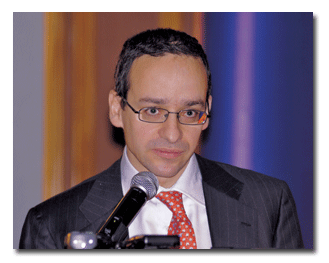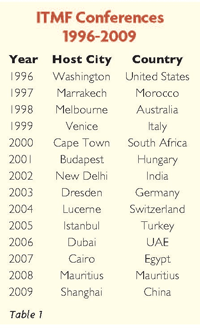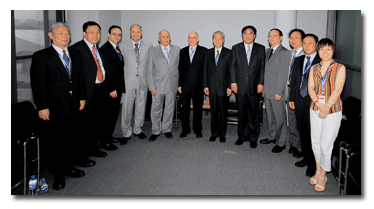F
or more than 100 years, the Zürich, Switzerland-based International Textile Manufacturers
Federation (ITMF) has served the entire textile industry around the world. ITMF organizes an annual
conference and publishes much-appreciated statistics on shipments and stocks from the entire
textile production chain. The conference is considered to be the most important gathering of the
global textile industry. In an exclusive interview with
Textile World
, ITMF Director General Dr. Christian P. Schindler explained ITMF’s activities and the
reasons Shanghai was chosen as the host city for this year’s conference.
ITMF – one of the oldest non-governmental organizations and probably the most important and
highest-ranking textile association around the world – was founded in 1904 at a meeting convened in
Zürich at the initiative of the British cotton spinning industry. Initially, it established its
headquarters in Manchester, England, and for many years, ITMF represented and promoted the
interests of the cotton spinning and manufacturing industries around the world. The rapid
development of man-made fibers broadened the range of membership. At the same time, vertical
integration in textile enterprises changed the structure of the industry, and the federation
enlarged its scope and became a multi-fiber and multi-process industry association.

Dr. Christian P. Schindler started his work with ITMF as an economist and was elected
director general effective Jan. 1, 2007.
Move To Switzerland
ITMF was directed for many years by Dr. Herwig Strolz, who appointed Schindler as ITMF’s
economist on Oct. 1, 2004. Schindler was promoted to the position of director in 2006, and at the
federation’s annual conference in Dubai in September 2006, he was elected director general
effective Jan. 1, 2007.
TW
: Dr. Schindler, in 1963, the federation’s headquarters were moved from Manchester, England,
to Zürich, Switzerland. Why was that done?
Schindler: Well, this was for the purpose of facilitating international contacts
and improving administrative services and communications. On top of that, Switzerland was and is a
neutral country and therefore an ideal place for an international association.
Since 1960, ITMF’s membership has expanded significantly and today embraces most of the
world’s textile production. The location of global textile industry capacities has undergone
far-reaching changes, and the readjustment process has also affected the structure of industry
trade associations. The former fragmentation of those organizations has shifted gradually as their
framework of representation has become more concentrated and integrated.
In 1978, the federation changed its name to International Textile Manufacturers Federation.
With its current structure and scope, ITMF is eligible to represent the broadest possible range of
the world’s textile industries, and it does.
Membership
Like every association, the body of ITMF is composed of its members – associations and other
constituted organizations of textile manufacturers. There can be only one member association from
each country. The members have access to all annual statistics as well as other important data and
committee papers. It is also possible to become an associate member. These are associations and
other constituted organizations of textile manufacturers in countries in which there is already a
member association, as well as associations allied to the textile industry.
In recent years, corporate memberships have been made available to manufacturers of textiles
or of products allied to the textile industry, such as textile machinery.
TW
: Is it easy to become a corporate member of ITMF? What are the costs of the membership?
Schindler: The main purpose of offering corporate membership is to offer companies
that are not represented already by a national textile association access to our international
platform. It is a fairly easy procedure to become a corporate member. An interested company applies
in writing for corporate membership. Afterwards, the existing membership is informed and asked to
approve the application. The cost for corporate membership is between 5,000 and 10,000 Swiss
francs, depending on the turnover.
Main Objectives
TW:
What are the main objectives of ITMF?
Schindler: First of all, we provide a neutral forum and platform for discussions
of matters appropriately within the common interest and concern of textile companies. The ITMF
conferences offer an ideal forum to discuss and exchange views and opinions in a relaxed atmosphere
outside the day-to-day business. Furthermore, we act as a central agency of the textile industries
for the collection of information, statistical and otherwise, on textile manufacturing developments
in all countries of the world. Another important point is the role as a voice for the world textile
industry in issues relating to raw materials. Different committees serve as a forum for the
industry and its partners as a platform like the Spinners Committee, the Joint Cotton Committee and
others. The federation also acts as a kind of liaison agent among the textile industries and
governments and intergovernmental organizations interested in the textile industry.

Meeting Point
ITMF is without any doubt the most important global meeting point for networking. The
highlight of ITMF is the annual conference, held in different locations around the world. The
conference provides an opportunity for the most important top-ranking people to meet – to attend an
excellent conference, but also to exchange and strengthen contacts with the leaders of the global
textile machinery and textile industries and, last but not least, with governmental officials.
These high-level gatherings are probably even more important than the statistics. Venues
from 1996 to the present are shown in Table 1.
TW
: How do you organize the annual conference, and who is responsible for the program?
Schindler: As you know, the conference moves around the world every year. Members
of the federation are usually hosting the conference and are therefore assisting in organizing the
event. It really is a joint effort. The special feature of an ITMF Annual Conference is its truly
international character with regard to speakers and attendees combined with the possibility for the
national host association to direct broad attention to its textile industry.

On April 17, 2008, the China National Textile and Apparel Council (CNTAC) officially joined
ITMF as a new member association in an official ceremony at ITMA Asia + CINTE 2008. Former ITMF
president Walter Simeoni (sixth from left) and CNTAC President Du Yuzhou (seventh from left) were
at the center of attention.
China, 2009 ITMF
Annual Conference Host Country
On April 17, 2008, the China National Textile and Apparel Council (CNTAC) officially joined
ITMF as a member association. This membership is considered to be very important for both
organizations. CNTAC represents the largest textile-producing, -consuming and -exporting country in
the world and strengthens ITMF’s international representation. On the other hand, ITMF offers an
ideal international platform for the Chinese textile industry.
TW
: This year’s conference is something special for ITMF. For the first time in its long
history, the ITMF Annual Conference takes place in Shanghai, Oct. 23-25, 2009. What does it mean
for ITMF to hold its annual conference in China?
Schindler: It is indeed special to hold this year’s ITMF Annual Conference in
Shanghai, one of the most booming cities in the world, with a huge textile cluster in and around
the city. As the world’s biggest producer of textiles with the largest domestic market and one of
the fastest-growing economies in the world, China is and will be of great importance as a
production site and increasingly also as an export market. The conference is therefore an ideal
opportunity for everybody who is interested to learn more about China and its future role in the
global textile arena.
Committees
TW
: How do you cover the different areas within ITMF?
Schindler: We offer these groups different committees in which they can meet and
work. All member associations and associate and corporate members are entitled to be represented,
as appropriate, on these sub-committees and to take an active part in their work.
The Spinners Committee’s main objectives are to support the development of quality cotton
fiber based on modern spinning requirements; to provide advice relating to the harvesting, handling
and ginning of cotton; and to promote the mechanical testing of raw cotton.
The Joint Cotton Committee is composed of delegates who represent sellers and buyers of raw
cotton. It is concerned with any matters pertaining to raw cotton production and marketing,
including international cotton marketing policies.
ITMF deals with governments, international organizations and trade associations interested
in raw cotton production, trading and marketing through the Joint Cotton and the Spinners
Committee.
The task of the Statistical Committee is to supervise, improve and extend ITMF’s statistical
services; and to keep member associations and associate members informed of relevant statistics
that are compiled by other international organizations.
The International Committee on Cotton Testing Methods is mainly concerned with matters
related to cotton fiber testing and standardization. The Man-Made Fibres Committee deals with
specific matters in the production, distribution and processing of man-made fibers on an ad-hoc
basis.
The Future Of ITMF
TW
: The ITMF statistics are very much appreciated among the members and recipients for their
high value. Are you pleased with the content, or is there a way to further enhance the results?
Schindler: Well, among our various publications, ITMF’s International Textile
Machinery Shipment Statistics is certainly the most renowned. It is unique in the world and serves
the entire industry as basic information on ongoing structural changes in the scale and scope of
textile production capacities around the world. To readers of these statistics, it wasn’t a
surprise that the investment boom in new textile machinery during the past six years was not
sustainable. The statistics have been collected for 30 years, and its coverage was expanded
constantly. We now cover the different segments of spinning, texturing, weaving, and circular and
flat knitting as well as finishing machinery. In the future, we also intend to include the segment
of printing machinery. The world’s most important textile machinery manufacturers are participating
in this statistics already, but we are, of course, always welcoming any new participants. In
general, the compilation of statistical information on textile production has become more difficult
these days due to a lack of official data being available in many countries.
TW
: Are you happy so far with how ITMF is presenting itself today?
Schindler: The global textile industry has been undergoing tremendous structural
changes in the past 10 to 15 years and is now affected by the most severe global economic crisis
the industry has seen since the Great Depression in the last century. These structural changes ask
for continuous adaptations of the federation’s activities and services. Despite the current crisis,
we will continue to work hard on offering enhanced and new services.
TW
: And what are the next targets of the federation?
Schindler: Our target is always to provide our members an attractive international
and neutral platform where they can meet, learn and exchange their views. The value of our
conference lies in the opportunity to get a feeling for the international development and changes
as well as an outlook of the global textile industry, and to build an international network with
partners from the entire textile value chain including scientists and other experts from the
industry. Additionally, we are always trying to improve our existing publications and to develop
new ones.TW: We wish you all the best to achieve your targets.
Dr. Christian P. Schindler,
ITMF Director General
German-born ITMF Director General Dr. Christian P. Schindler studied economics at the
University of Fribourg, Switzerland, graduating in 1994. Between 1995 and 1998, he served as
personal assistant to two members of Parliament in Germany’s Bundestag. In 1998, he joined the
Federation of German Wholesale and Foreign Trade as personal assistant and speechwriter for the
association’s president. Between 2001 and 2004, he studied at the Institute for Economic Policy at
the University of Cologne, Germany, where he wrote his dissertation and earned a doctorate in 2004.
September/October 2009




